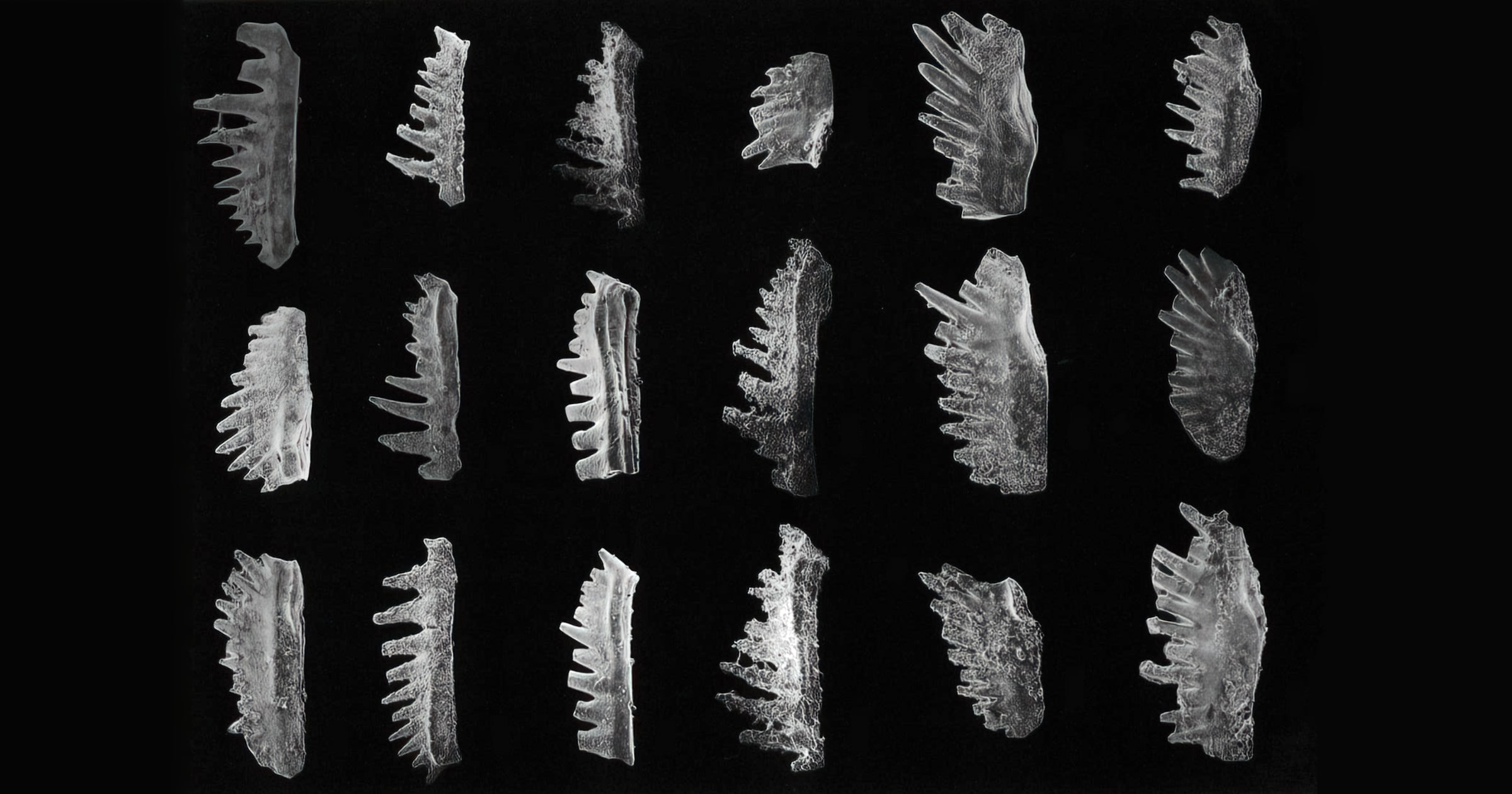 Evolution
Evolution
 Paleontology
Paleontology
Fossil Friday: The Gupta Scandal

This Fossil Friday features conodont microfossils from the Triassic of the Himalaya region in India (Goel 1977) to illustrate a veritable crime story. You may have heard of cases of fraud in paleontology such as the famous hoaxes of Piltdown Man and Archaeoraptor, but the greatest scientific fraud of the century is not so well known outside of professional paleontologist circles. It was Indian scientist Vishwa Jit Gupta, professor of geology at Panjab University, who played the “star role” in this biggest case of fraud in paleontology and maybe all of science ever (Lewin 1989).
A Dubious Accident
Gupta was India’s most celebrated paleontologist, with 455 scientific publications (including two Nature papers and five books), when the scandal started to come to light in 1989 (Talent 1989, Lewin 1989, Anderson 1991, Nature 1993), but it took nine years for the total truth and magnitude of the scandal to be revealed (Ruffell et al. 2012, Webster 2016). It turned out that over 30 years of research with 126 gullible co-authors, Gupta had falsified data, stolen fossils from colleagues and collections around the world, and then claimed to have found them in the Himalayas, often in made-up localities and layers. Gupta’s “fraudulent practices have involved most invertebrate phyla as well as the vertebrates and include fossils of Cambrian to Cenozoic age” (Webster et al. 1993). Gupta did not only commit scientific fraud on an unprecedented scale, but he even issued death threats with head money to whistleblowers including Australian geologist John Talent, one of whom one was actually killed in a dubious accident (Carleton 2005, Ruffell et al. 2012). After a final report in 1994 found Gupta guilty of all charges, “an article in the Indian weekly The World called for Gupta to be stripped of his PhD and DSc degrees, both of which had been demonstrated to be based upon fraudulent work. Strangely, though, when the Academic Senate of the Panjab University met to decide Gupta’s fate, only five out of the 55 senators voted for his dismissal. Gupta was allowed to keep his position within the university, to supervise research students and to retain his degrees” (Fossil Industry 2022).
Good to Remember
Gupta retired normally in 2002, with super-annuation benefits (Patnaik 2015), and none of his fraudulent publications has been retracted. Nor was he ever held legally accountable for his unbelievable misconduct. In 2013 a book was finally published in India about the case (Shah 2013). Nowadays, such a scandal would likely never have been uncovered at all, because political correctness would hardly allow anyone to accuse a scientist from a non-Western country of such outrageous behavior or even find that “India is also a leading nation in fraudulent scientific research” (Patnaik 2015). An obvious question that is also not allowed to be asked concerns the desolate state of a whole scientific discipline, where such a massive fraud could happen in the first place and stay unnoticed for decades. Good to remember when somebody tells you to just trust in science and to stop asking inconvenient questions.
References
- Anderson I 1991. Himalayan scandal rocks Indian science. NewScientist Febr. 9, 1991. https://www.newscientist.com/article/mg12917551-600-himalayan-scandal-rocks-indian-science/
- Carleton S 2005. What happens to the Whistleblowers? ABC The Science Show Sept. 3, 2005. http://web.archive.org/web/20050911052826/http://www.abc.net.au/rn/science/ss/stories/s1451250.htm
- Fossil Industry 2022. A famous case of Indian fossil fraud and theft. Fossil Hunters Dec. 21, 2022. https://www.fossilhunters.xyz/fossil-industry/a-famous-case-of-indian-fossil-fraud-and-theft.html
- Goel RK 1977. Triassic Conodonts from Spiti (Himachal Pradesh), India. Journal of Paleontology 51(6), 1085–1101. https://www.jstor.org/stable/1303823
- Lewin R 1989. The Case of “Misplaced” Fossils. Science 244(4902), 277–279. DOI: https://doi.org/10.1126/science.244.4902.277
- Nature 1993. Palaeontology under a Himalayan shadow. Nature 366(6456), 616. DOI: https://doi.org/10.1038/366616a0
- Patnaik PR 2015. Scientific Misconduct in India: Causes and Perpetuation. Science and Engineering Ethics 22(4), 1245–1249. DOI: https://doi.org/10.1007/s11948-015-9677-6
- Ruffell A, Majury N & Brooks WE 2012. Geological fakes and frauds. Earth-Science Reviews 111(1-2), 224–231. DOI: https://doi.org/10.1016/j.earscirev.2011.12.001
- Shah SK 2013. Himalayan Fossil Fraud – A View from the Galleries. Palaeontological Society of India Special Publication 4, University of Lucknow, 141 pp.
- Talent JA 1989. The case of peripatetic fossils. Nature 338(6217), 613–615. DOI: https://doi.org/10.1038/338613a0
- Webster GD 2016. An evaluation of the V. J. Gupta echinoderm papers, 1971–1989. Journal of Paleontology 65(6), 1006–1008. DOI: https://doi.org/10.1017/S002233600003331X
- Webster GD, Rexroad CB & Talent JA 1993. An Evaluation of the V. J. Gupta Conodont Papers. Journal of Paleontology 67(3), 486–493. https://www.jstor.org/stable/1306034
